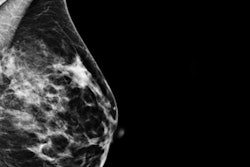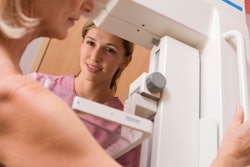
CHICAGO - Contrast enhanced digital mammography (CEDM) can reduce biopsies of benign breast lesions, according to research presented on Sunday at the RSNA 2018 meeting.
The findings address mammography critics' concern that regular breast cancer screening exposes women to the harms of overdiagnosis and unnecessary procedures -- of which biopsies of BI-RADS 4A (low suspicion of malignancy) and BI-RADS 4B (moderate suspicion of malignancy) lesions are an example, wrote a team led by presenter Dr. Margarita Zuley of the University of Pittsburgh.
"One criticism of breast imaging is the harm caused by the relatively high rate of biopsy of benign breast lesions -- particularly BI-RADS 4A and 4B lesions," the group wrote. "[We sought] to assess if CEDM during diagnostic evaluation could increase biopsy [positive predictive value] for soft-tissue density lesions by reducing benign biopsies while not impacting biopsy of cancers."
Zuley and colleagues included 57 women between the ages of 34 and 74 with 60 BI-RADS 4A or 4B soft-tissue lesions diagnosed on mammography, digital breast tomosynthesis (DBT), or ultrasound. All of the patients were scheduled for biopsy between April 2016 and November 2017.
The women underwent a CEDM exam immediately before having the biopsy. Radiologist readers reviewed the diagnostic exams and provided three BI-RADS scores: one for digital mammography/DBT, another for digital mammography/DBT with ultrasound, and a third for digital mammography/DBT with CEDM.
After digital mammography/DBT and ultrasound and before CEDM, 72% of BI-RADS ratings were greater than BI-RADS 4. However, after CEDM, 60 of these were reclassified as less than BI-RADS 3, for a 35% average biopsy recommendation reduction.
Zuley and colleagues also found the following:
- Adding ultrasound to digital mammography/DBT converted 44 of 204 benign lesions to a BI-RADS category of less than 4 and 10 of 204 benign lesions to a BI-RADS category of less than 3.
- Adding CEDM to digital mammography/DBT converted eight of 204 benign lesions to a BI-RADS category of less than 4 and 60 of 204 benign lesions to a BI-RADS category of less than 3.
- Reassignment of actual cancers to new BI-RADS categories was low: With ultrasound, three of 36 cancers were reassigned to a category of less than 4, while two of 36 were assigned to a category of less than 3. With CEDM, one of 36 cancers was reassigned to a category less than 4, and one of 36 was assigned to a category of less than 3.
The study results suggest that CEDM offers a better way to assess the need for biopsy, according to the researchers.
"Using CEDM during diagnostic evaluation of BI-RADS 4A or 4B soft-tissue lesions may significantly reduce the number of women recommended for benign biopsy while missing very few cancers," they concluded.




















